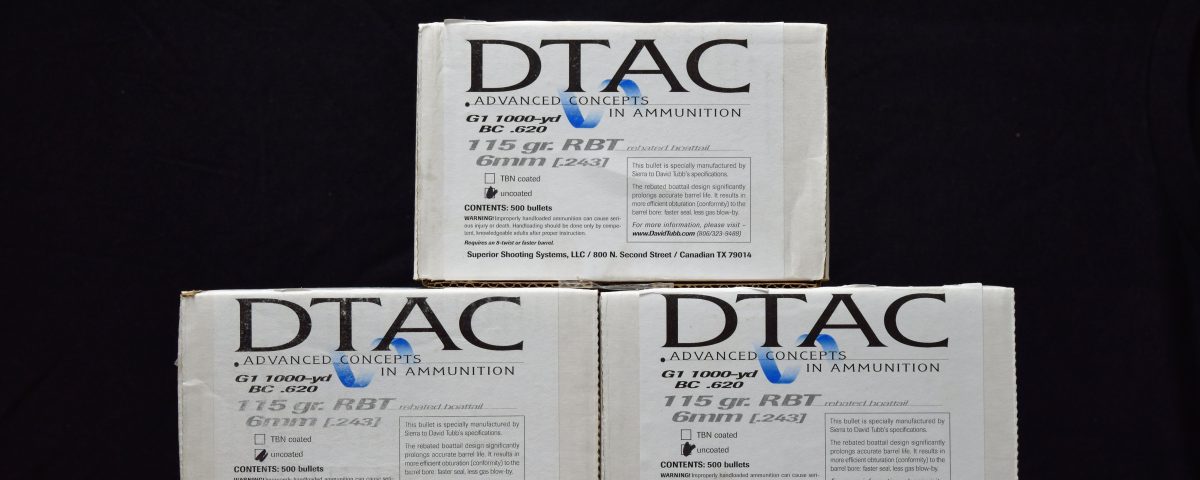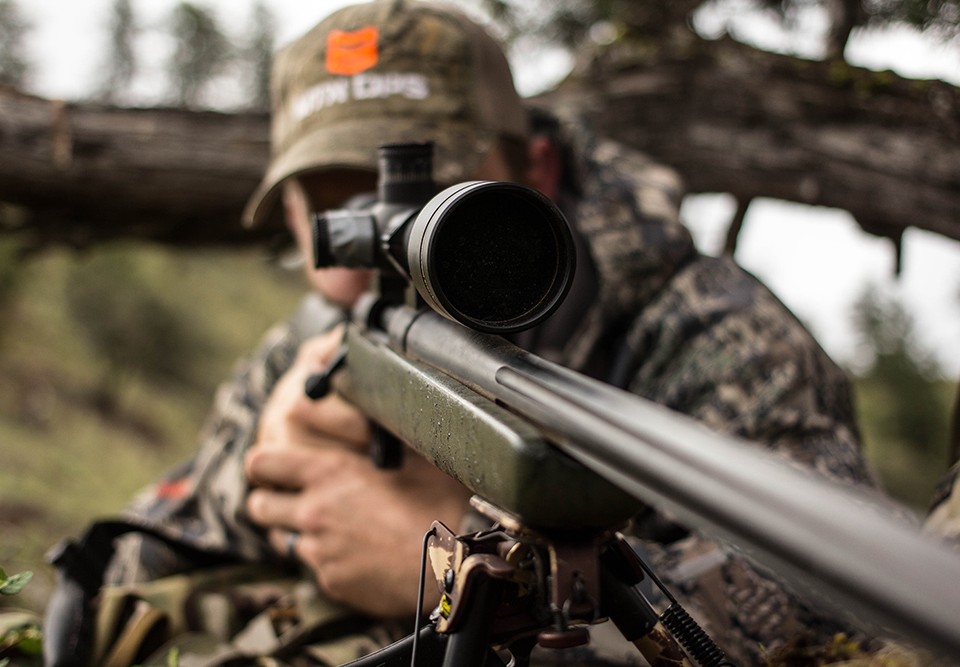New 6mm 115gr DTAC from David Tubb

About RBros Custom Rifles
April 1, 2016RBH Cartridge Lineup
January 7, 2019The purpose of this article is to review the new 6mm 115 DTAC bullet by David Tubb. Although this is not a DTAC vs Hybrid article, I will be comparing it with the Berger 105 Hybrid. The Hybrid is currently the most popular bullet for the 6mm in the PRS/Tactical style matches, so it only makes sense to see how the DTAC stacks up against a known performer. I would first like to point out that we are in no way sponsored by or otherwise influenced by Tubb or his company Superior Shooting Systems. The bullets were purchased, not donated for testing. This is an unbiased review of the bullets. Now that we have that out of the way, let’s get to the review.
We have been using the original 115 DTAC since 2009 on and off in different 6mm rifles. They always needed sorting to get the best results, but were accurate and had a slight BC gain over the 105’s. The new bullets are of a different design using a rebated boat tail instead of the standard match bullet boat tail. In order to ensure accuracy I have taken the following statement from Tubb’s post:
“David Tubb: Here are couple of reasons that the RBT design was selected. These are not based on the RBT being a ballisticaly superior to a conventional boattail design. If the new DTAC 115 RBT was produced in a conventional boattail shape the G1 (1000yd) BC numbers would be very close.
The Rebated Boattail design was selected because;
1. Easier to precisely hold tolerances when manufacturing the 7 degree boattail angle– most conventional boattails have 9 degree angles (or greater).
2. RBT more efficiently opturates to the bore of the rifle barrel when fired. (Mimics a flat base bullet design). This will allow the RBT design to extend your accurate barrel life by reducing gas leakage around the bullet when fired in a worn 6mm throat.”
Since I am not a bullet manufacturer, I cannot confirm or deny the manufacturing tolerances between the RBT style and conventional boat tail bullets. I will agree with David on the flat base bullets sealing up worn 6mm throats a little better however. This is partially the reason the short range benchrest folks run them in their 6mm rifles. Whether or not the RBT design will mimic it and give us more useful life is still to be seen. All of the RBT style bullets I have used were very accurate, so I was excited to try these out. At first glance in the box, the bullets look slightly sleeker than the previous gen DTAC’s, and the point tipping has a longer shallow angle. The tips are all nicely closed and even. The RBT isn’t as pronounced as some other designs I have seen, but should still work to the same concept as above. Some have said that this bullet is identical to the original DTAC, just with a rebated boat tail. From what I am seeing, that definitely isn’t the case. The new bullet differs in OAL, bearing surface length and base to ogive.
Let’s dive into the details. For this comparison I took a random sample of 25 bullets. The new DTAC’s, the older generation DTAC’s, and the competition proven Berger 105 Hybrid. Again, this isn’t meant to be a DTAC vs Hybrid comparison. I simply wanted to see how the bullets consistency stacked up against a proven performer. The results were actually a little surprising.
As I mentioned earlier, with the previous generation of DTAC’s, bullet sorting helped out in the consistency and accuracy department. It wasn’t uncommon to have a BTO length that varied .008-.010” and a bearing surface variance in the .005-.008” range. What does this mean? It all depends. Even with unsorted bullets, we were still seeing sub 1/2moa groups, but would get a flier that would go ¾” or more out of the group. Most of the guys that were shooting them had either jammed or jumping them .040”+ so that the variance didn’t make such a big difference. When the 105 Hybrid came on to the scene, it pretty much took over the 6mm competition bullet market. The BC wasn’t that far behind a DTAC, but its consistency seemed to be better, plus the extra speed and a faster twist closed the gap in performance even more.
OK, now for the DATA! This is a random 25pc sample from each bullet.
| New DTAC | Old DTAC | 105 Hybrid | |||||||
| Bearing (in) | BTO (in) | Weight (gr) | Bearing (in) | BTO (in) | Weight (gr) | Bearing (in) | BTO (in) | Weight (gr) | |
| 1 | 0.5805 | 0.7730 | 115 | 0.5875 | 0.7450 | 115.0000 | 0.4855 | 0.6425 | 105.0000 |
| 2 | 0.5800 | 0.7745 | 114.9 | 0.5925 | 0.7515 | 115.0000 | 0.4845 | 0.6410 | 105.0000 |
| 3 | 0.5810 | 0.7750 | 115 | 0.5875 | 0.7445 | 114.0000 | 0.4835 | 0.6410 | 105.0000 |
| 4 | 0.5850 | 0.7745 | 115 | 0.5895 | 0.7455 | 115.0000 | 0.4845 | 0.6405 | 104.9000 |
| 5 | 0.5800 | 0.7720 | 115 | 0.5895 | 0.7485 | 115.0000 | 0.4835 | 0.6405 | 104.9000 |
| 6 | 0.5810 | 0.7740 | 115 | 0.5920 | 0.7520 | 115.0000 | 0.4840 | 0.6420 | 104.9000 |
| 7 | 0.5805 | 0.7725 | 115 | 0.5895 | 0.7470 | 114.9000 | 0.4875 | 0.6430 | 105.0000 |
| 8 | 0.5800 | 0.7730 | 115 | 0.5870 | 0.7455 | 114.9000 | 0.4845 | 0.6410 | 104.9000 |
| 9 | 0.5810 | 0.7750 | 115 | 0.5875 | 0.7455 | 114.9000 | 0.4865 | 0.6420 | 105.0000 |
| 10 | 0.5810 | 0.7735 | 115 | 0.5895 | 0.7500 | 114.9000 | 0.4870 | 0.6430 | 104.9000 |
| 11 | 0.5815 | 0.7740 | 115 | 0.5880 | 0.7475 | 114.9000 | 0.4850 | 0.6415 | 104.9000 |
| 12 | 0.5800 | 0.7745 | 115 | 0.5880 | 0.7465 | 115.0000 | 0.4870 | 0.6420 | 104.9000 |
| 13 | 0.5810 | 0.7745 | 115 | 0.5890 | 0.7520 | 115.0000 | 0.4850 | 0.6415 | 104.9000 |
| 14 | 0.5800 | 0.7740 | 115 | 0.5905 | 0.7475 | 115.0000 | 0.4825 | 0.6405 | 104.8000 |
| 15 | 0.5805 | 0.7735 | 114.9 | 0.5925 | 0.7545 | 115.0000 | 0.4870 | 0.6435 | 105.0000 |
| 16 | 0.5805 | 0.7735 | 114.9 | 0.5895 | 0.7480 | 115.0000 | 0.4870 | 0.6425 | 105.0000 |
| 17 | 0.5805 | 0.7735 | 115 | 0.5890 | 0.7500 | 115.0000 | 0.4870 | 0.6440 | 105.0000 |
| 18 | 0.5800 | 0.7730 | 115 | 0.5900 | 0.7480 | 115.2000 | 0.4850 | 0.6440 | 104.9000 |
| 19 | 0.5805 | 0.7730 | 115 | 0.5890 | 0.7445 | 115.0000 | 0.4835 | 0.6435 | 104.8000 |
| 20 | 0.5810 | 0.7735 | 115 | 0.5885 | 0.7455 | 115.0000 | 0.4855 | 0.6440 | 104.9000 |
| 21 | 0.5810 | 0.7740 | 115 | 0.5885 | 0.7455 | 115.0000 | 0.4840 | 0.6450 | 105.0000 |
| 22 | 0.5810 | 0.7740 | 115 | 0.5895 | 0.7470 | 115.0000 | 0.4860 | 0.6460 | 105.0000 |
| 23 | 0.5805 | 0.7735 | 115 | 0.5885 | 0.7495 | 115.0000 | 0.4870 | 0.6450 | 105.0000 |
| 24 | 0.5815 | 0.7740 | 115 | 0.5870 | 0.7450 | 115.0000 | 0.4840 | 0.6445 | 105.0000 |
| 25 | 0.5810 | 0.7730 | 115 | 0.5895 | 0.7480 | 115.0000 | 0.4875 | 0.6450 | 105.0000 |
| Min | 0.5800 | 0.7720 | 114.9000 | 0.5870 | 0.7445 | 114.0000 | 0.4825 | 0.6405 | 104.8000 |
| Max | 0.5850 | 0.7750 | 115.0000 | 0.5925 | 0.7545 | 115.2000 | 0.4875 | 0.6460 | 105.0000 |
| Std Dev | 0.00099 | 0.00075 | 0.03317 | 0.00152 | 0.00269 | 0.20640 | 0.00150 | 0.00163 | 0.06506 |
| Avg | 0.5808 | 0.7737 | 114.9880 | 0.5892 | 0.7478 | 114.9480 | 0.4854 | 0.6428 | 104.944 |
New DTAC Specs:
Bullet Length: 1.344”
Bearing Surface Length (Avg): .5808”
BTO (Base to Ogive Avg): .7737”
Ogive to Tip (Avg): .5693”
BC: .620 G1
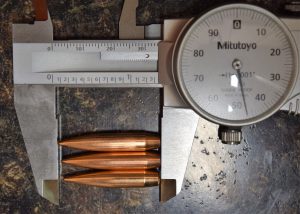
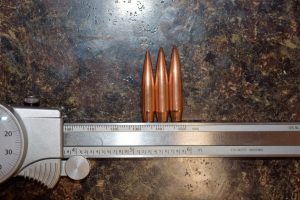
Photo from top down: New DTAC, Old DTAC, Berger 105 Hybrid Left to Right: 105 Hybrid, Old DTAC, New DTAC
I really figured that the Berger would be a little more consistent in its measurements. The variance in the bearing surface was .005”, and the BTO was .0055”. The new DTAC was the same .005” variance in the bearing surface, but it was all due to 1 bullet measurement. With that one sample out, the variance drops to .0015”. Pretty good considering that the old generation was .0055” with numbers all over the place. This supports Tubb’s claims on the RBT boat tail being more consistent to manufacturer. Also, notice the BTO on the new one is a .003” variance. That’s almost half of what the Berger measures, and a substantial amount less than the .010” variance of the previous gen DTAC. The weight was very consistent also, but I think a guy needs a better scale to get a true reading on them. I just used the Chargemaster scale for this portion of the test.
Now, what does it all mean. In long range shooting, one wants to eliminate every variable that you can. You use the best equipment, sound reloading practices, etc…. In my opinion, a more consistent bullet eliminates the variable. Now, with that said, by looking at the number on the 105 Hybrid, that variable may be small. But data is data and it doesn’t lie from a numbers standpoint. So that brings us to the real world part!
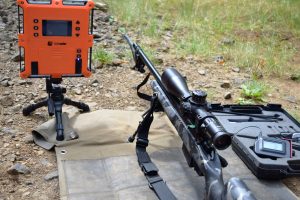
Now in full disclosure, I did not shoot the following on paper at distance. That part is going to take some more time and I wanted to get the information out there for guys to make their own decision. I can tell you this bullet has been tested for quite some time before it became available to sell. The guys that were testing it are vocal and would say if it wasn’t accurate. So, my targets on this session were similar to what we use in matches, maybe slightly smaller.
The rifle used was a R Bros Competitor in 6mm SLR. We run all our 6mm’s in a 7.3 twist and have since 2008. With the hybrids it gives us a slight BC boost, but more importantly it seems to carry accuracy better at longer distances. During my quick load workup, I developed a decent load that shot pretty consistent in the .3’s, ran 3098 with and ES of 4. I am going to tweak things a little more, but it will work for this test of the BC.
Now, Tubb states this bullet has a .620 BC and will run in an 8 Twist. I have no doubt on the running in a 8 twist, since the old ones will just fine. The .620 BC seemed a little high. Honestly, I was figuring if they ran the same BC as the old ones (.585) but were more consistent, I would be happy. That is why we bought enough to last us a season.
Plugging the speed and BC into my Kestrel I proceeded to shoot targets from 764-1196yds. This is where it gets a little interesting. From 764yds to 998yds, I was actually about .1mil high. Now before you say my chrono data or zero was off, this is not the case. I ran a Magneto Speed and Labradar together and the numbers came up within 1fps of each other during the load check. The zero is on as well at 100yds. 3 shots were fired at each target and I was happy that groups were well under the 1/2moa mark with most going into the same splash mark. The only thing I had to shoot at the 1196 spot was a rock that was little over 1/2moa. First shot hit the left edge on the rock, the 2nd hit very close to center, slightly left. All the wind holds were also based on the .620BC which was pretty nice considering the 8-13mph winds today. My guess is that in distances out to ~1k, I am seeing a slight boost in BC running the bullet at close to 3100fps in a 7.3 twist. I will test again on a calm day, could have been updrafts from the canyons at that part my shooting area.
All in all, I am pretty pleased with the bullets so far. Testing will continue, but I believe this bullet is a viable option for the 6mm in matches. We will be running them in the upcoming year of matches as long as they keep performing as they are. Besides, who doesn’t like more performance and consistency for less money. The PRS style shooting is expensive, so this is a welcome commodity.


